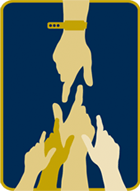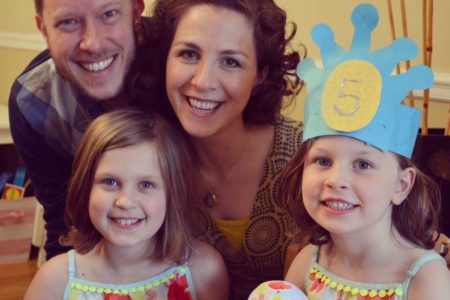My name is Sarah Rosenfeld and I’m an NIH patient and volunteer.
I’m passionate about paying forward the amazing gift of care and life that my dedicated NIH doctors and researchers have given to me. I’m working to support patients through Friends of Patients at the NIH because I know how incredibly scary and isolating it can be to face a life-threatening disease – and what an oasis of hope the NIH can be.
My story begins eight years ago when I had a C-section. I had an epidural but it didn’t block a thing! I felt excruciating pain. Then five years ago at the birth of my second daughter, I discussed with my doctor how the pain medication had failed and we had a new plan. But once again, I felt pain throughout. Imagine two un-medicated cesarean sections!
My husband and I were shocked. We pressed the anesthesiologists for answers but no one could provide any insights at the time. Our daughters were both born healthy so we put the terrible C-sections behind us and moved on.
But then, in 2015, I had excruciating pain shooting down my leg for many weeks. I couldn’t walk, drive, sleep, or get through a typical day with my young daughters. My internist and I assumed it was sciatica and I did weeks of physical therapy. After nothing dulled the pain, I had an MRI. Voila! I had a tumor which was pinching my sciatic nerve. That explained why the epidurals didn’t work; the tumor blocked my spinal canal.
That led to more tests, and in February 2016, I was diagnosed with myxopapillary ependymoma, a fancy name for a rare central nervous system tumor. These types of tumors are overwhelmingly slow-growing, can present in both adults and children, and are found in the spinal canal and brain. The most common treatment is surgery and radiation followed by close monitoring and imaging for many years.
Once the shock of the diagnosis wore off, my husband I went into research mode and met with neurosurgeons at almost every hospital in the DC Metro area. We learned that most ependymomas are typically solid and can be removed by a skilled neurosurgeon in a relatively routine surgery. But my version was a bit more complicated.
I had my first surgery in April 2016. The surgeon discovered the tumor was unencapsulated meaning it was spread throughout the lower region of my spinal canal and impossible to fully remove. I was told to schedule annual scans to monitor the remaining tumor tissue.
This was advice I just couldn’t accept. I sought a second opinion and was referred to the National Institute of Neurological Disorders and Stroke (NINDS) at NIH where I learned that the best chance for complete and total remission would mean undergoing a second surgery and possible radiation. I was told this was absolutely necessary.
In October 2016, I had a second nine-hour surgery followed by six weeks of radiation. I now have follow up appointments and brain/spine scans every few months.
I grew up in Potomac, Maryland with NIH in my backyard. I must’ve driven by the campus thousands of times but never could’ve imagined I’d be a patient there one day. Now that I’ve recovered from everything that’s happened in the last year, I’ve had time to reflect and redirect my energy to what’s most important to me—my family, my friends, and the NIH.
I’m proud to say, today, there’s a neuroscience researcher studying my tumor tissue that will hopefully lead to a cure for central nervous system tumors in the future. I’m so fortunate to be enrolled in a research study and forever grateful for the incredible care I have received.
One might certainly say I had a pretty awful stroke of bad luck. To be diagnosed with a tumor in your spinal canal sounds like something from a science fiction horror story, right?
When I have optimistic days, I remind myself that I’m under the care of the best and brightest minds in all of medicine just a few miles away from our house. I also have an amazing network of family and friends who supported us through this health scare both physically and emotionally. My husband also had the flexibility to take paid time off work, as needed, and work from home during my recovery.
Most patients don’t come to NIH from “just up the road.” They don’t have friends and parents nearby ready and willing to help with meals, childcare or a shoulder to cry on in the middle of the night. Their husbands must take leave without pay from their jobs to keep everything running smoothly at home. I strongly believe that together we must find the resources to support these patients, our friends, who are here from all over the globe enrolled in research studies.
These studies benefit all of humankind today, tomorrow, and for generations to come. For that reason, I’ve become a dedicated volunteer of Friends of Patients at the NIH and will continue to fundraise and spread the word until every patient has the type of emotional, financial, and physical support that I was so fortunate to have.
When I’m back on campus for appointments or scans, there’s always a small part of me that’s nervous but that quickly becomes a peaceful feeling. There’s the huge window where the kind-hearted nurse brought me so I could see the sunrise the morning of my surgery. I usually swing by to say hello to my favorite phlebotomist. If it’s a Thursday and my neurosurgery team isn’t in surgery, I go to visit them. Then I find myself sitting in the atrium soaking it all in, imagining all the thrilling discoveries taking place that very moment. Sometimes I can’t believe what’s happened to me but then I see how far I’ve come and how well I’m doing today. I’m here. I’m healthy. I’m brave.
Sarah Rosenfeld is a 38-year-old mother of two young girls. She lives with her family in Virginia. She recently hosted a successful Zumba party fundraiser for Friends at NIH proving again the words of a famous anthropologist, “Never doubt that a small group of committed, thoughtful people can change the world.” Indeed, Sarah changes the world for some of our patients.





